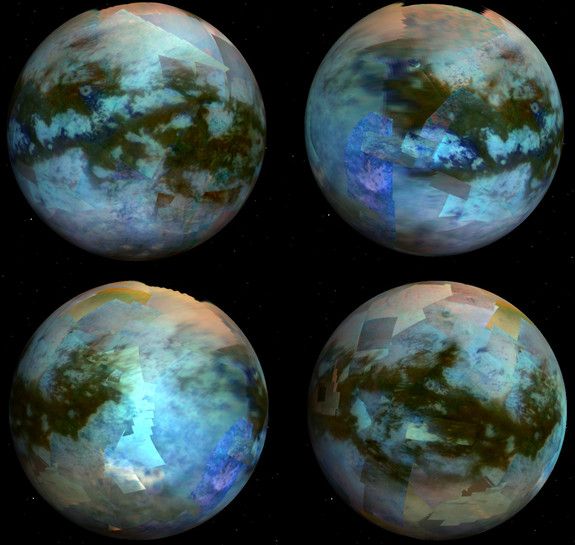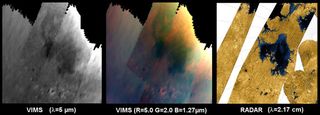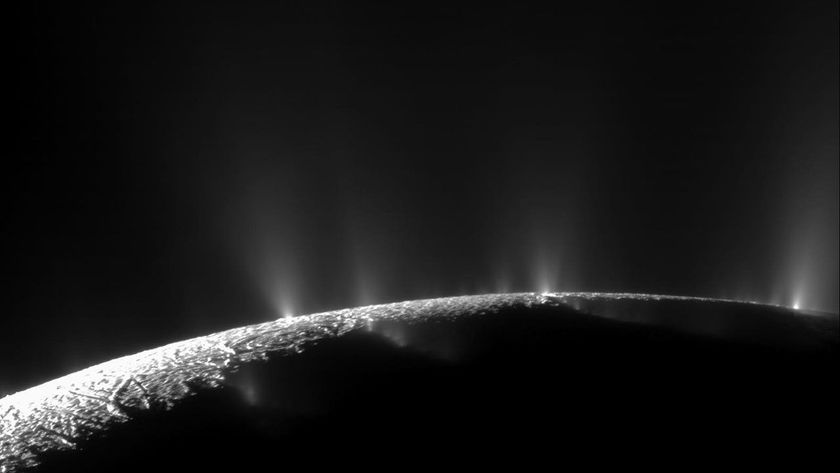New Map of Saturn Moon Titan Reveals Surprisingly Earth-Like Features

After meticulously stitching together images that were gathered over six years by a NASA spacecraft in orbit around Saturn, astronomers have created a global map of the surface of Titan, the ringed planet's largest moon, and it features some surprisingly Earth-like geological features.
An international team of astronomers, led by the University of Nantes in France, created the striking mosaic of Titan's surface using infrared images taken by the Visual and Infrared Mapping Spectrometer (VIMS) aboard NASA's Cassini spacecraft.
The global map and animations were presented Tuesday (Oct. 4) at the European Planetary Science Congress and the American Astronomical Society's Division of Planetary Science in Nantes, France. [See global map and video of Titan's surface]
The researchers used images that were taken during the Cassini mission's first 70 flybys of Titan. But, piecing together the map was an intricate and painstaking project because scientists had to comb through the pictures on a pixel-by-pixel basis to adjust illumination differences and other distortions caused by Titan's thick and hazy atmosphere, said Stéphane Le Mouélic, of the University of Nantes.
"As Cassini is orbiting Saturn and not Titan, we can observe Titan only once a month on average," Le Mouélic said in a statement. "The surface of Titan is therefore revealed year after year, as pieces of the puzzle are progressively put together. Deriving a final map with no seams is challenging due to the effects of the atmosphere — clouds, mist etc. — and due to the changing geometries of observation between each flyby."
Lifting the veil on Saturn's largest moon
Titan is the only moon known to be cloaked in a dense atmosphere, which is composed mainly of nitrogen. It also has clouds of methane and ethane, and ongoing research has presented increasing evidence for methane rain on the large, frigid moon.
Sign up for the Live Science daily newsletter now
Get the world’s most fascinating discoveries delivered straight to your inbox.
Since Titan is veiled in an opaque atmosphere, its surface is difficult to study with visible light cameras, and only a few specific infrared wavelengths can penetrate the haze. Cassini's infrared instruments and radar signals provide an intriguing glimpse down to the surface of the frozen body, which, as the new global map reveals, has some interesting Earth-like features.
"We have created the maps using low-resolution images as a background with the high-resolution data on top," Le Mouélic said. "In the few opportunities where we have VIMS imagery from the closest approach, we can show details as low as 500 meters [1,640 feet] per pixel. An example of this is from the 47th flyby, which allowed the observation of the site where the Huygens descent module landed. This observation is a key one as it might help us to bridge the gap between the ground truth provided by Huygens, and ongoing global mapping from orbit, which will continue up to 2017." [Video: Titan's Surprisingly Earth-Like Surface Revealed]
Cassini arrived in orbit around the ringed planet in July 2004, and has since made 78 flybys of Titan, the planet's largest moon. Currently, 48 more flybys are planned from now until the year 2017.

More details coming to light
On all of Cassini's flybys so far, the spacecraft's VIMS instrument has had only a few opportunities to observe Titan with high-spatial resolution. As a result, the global map of the moon shows some areas with more clarity and detail than others, the researchers said.
Putting together future maps of Titan will also allow scientists to observe seasonal changes on the surface of Titan and in the moon's atmosphere. For instance, as the northern hemisphere of Saturn and its moons shift into spring, some regions of the icy moon are only now coming into view, Le Mouélic explained.
"Lakes in Titan's northern hemisphere were first discovered by the RADAR instrument in 2006, appearing as completely smooth areas," Le Mouélic said. "However, we had to wait up to June 2010 to obtain the first infrared images of the northern lakes, emerging progressively from the northern winter darkness. The infrared observations provide the additional opportunity to investigate the composition of the liquids within the lakes area. Liquid ethane has already been identified by this means."
Cassini was launched in 1997 and arrived at Saturn in 2004. Last year, the spacecraft received a seven-year mission extension that will keep it operational through 2017.
This story was provided by SPACE.com, sister site to LiveScience. Follow SPACE.com for the latest in space science and exploration news on Twitter @Spacedotcom and on Facebook.













